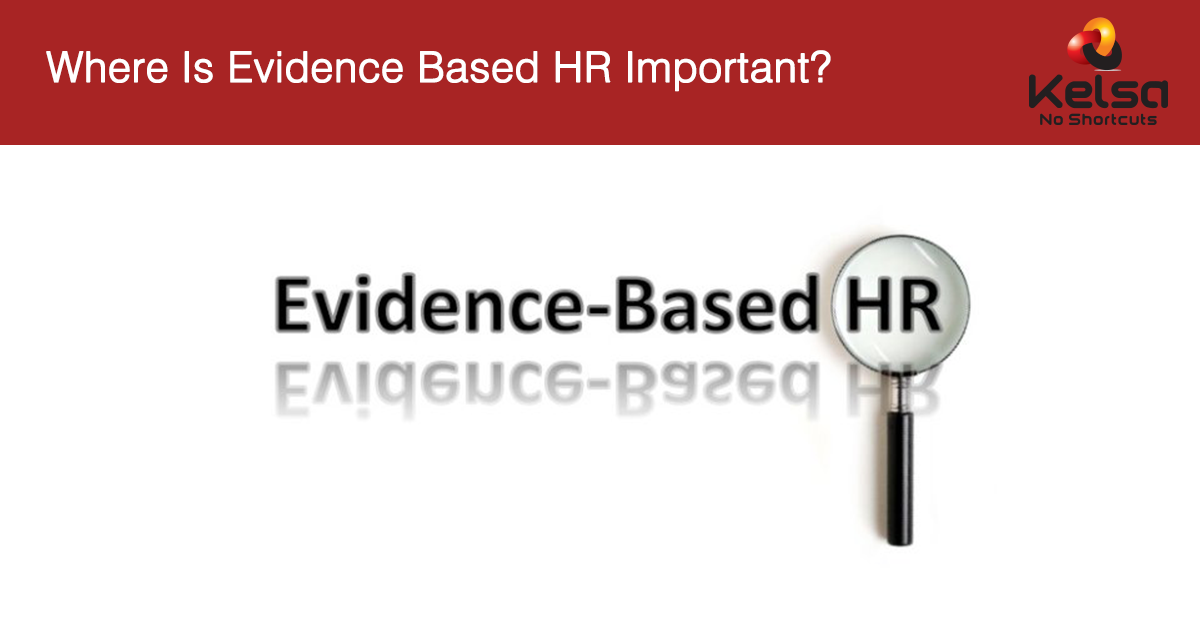Where is Evidence-Based HR important?

The financial year is heading to a close, and it’s the time of the year when HR leaders get busy with their teams to prioritise and plan key initiatives and outcomes for the year ahead. It is likely that with multiple mandates and competing priorities, much of their time and efforts will be spent sifting through options and approaches, and evaluating plans for maximum goal alignment and effectiveness.
Delivery approaches such as Evidence-based HR Management (EBHR) offer leaders greater success in managing such exercises. They enable credible systems to access evidence and data, and help leaders gain a deep understanding on key employee issues/business needs, to prioritise and design appropriate interventions.
As a practice, EBHR borrows from scientific disciplines such as Medicine and offers HR leaders new directions for thought and action. And as a planning and delivery approach – it emphasises on empirical frameworks and quantifiable outcomes and offers effective measures to harness use and respond to information.
Getting started with EBHR
To begin with, EBHR will demand that HR professionals get more focused on quantitative as against intuitive approaches to design and delivery of interventions. This will mean they derive improved ways to work and manage their information including –
Greater use of evidence
HR teams will use the best available historical or current evidence to evaluate design options and cultivate the required expertise/ values to manage initiatives.
Improved access to information
With EBHR rooted in data and evidence-based principles, templates will be developed to record and access key information, and plan, strategize and evaluate likely implementation scenarios.
Clarity and depth of understanding
HR leaders will gain a closer understanding of needs on the ground and improve their ability to vision outcomes, design policies and intervention to ultimately deliver effectiveness.
Meaningful and relevant initiatives
Working with strong evidence and data based measures, they will improve their abilities to create initiatives that are meaningful and relevant to varied groups within the organisation.
It is important to remember that EBHR is most effective when adopted within organisation structures that maintain readiness for empirical goals. HR leaders do run a risk of failure if they operate within intuitive cultures that depend on non-evidence based approaches, and will need to work actively to foster a strong data-driven culture that favours appropriate use/implementation of metrics and data.
This will require several measures including
- Fostering organisation-wide learning on data use and efficacy, and actively educating managers and employees on improving the quality of data capture and management.
- Fostering a team of HR practitioners who are ‘evidence-hungry’, adept at critical and lateral thinking, and rely on tested and verified diagnostic approaches to aid problem solving and decision making.
- Ensure evidence is sought and harvested at every opportunity, and solutions created are practical and specific to problem scenarios.
- Encouraging a solution based culture that is focused on best practice approaches. Further, they would use a sound evidential base to analyse possible outcomes and manage stakeholder expectations.
- Implement analytical approaches and gain greater access to industry analytics and statistics. Being consistent in their use of informed approaches to support decision making will deliver greater alignment between HR practice and organisational goals.
Effectively transitioning with EBHR
As with all change scenarios, HR leaders can expect that the path to implementing EBHR within a heavily data-centric culture need not necessarily be smooth and easy. They may need to plan effectively to manage some key challenges including –
Time and Costs
Implementing new approaches such as EBHR involves significant investment in upfront time and costs. So, it is important that HR leaders gain the commitment and support of the organisational leadership, and set clear expectation right at the outset. Phased EBHR implementations and prioritising on delivery are known to offer greater chances of success.
Disorganised data systems
While planning to adopt EBHR, leaders will likely observe that their function is significantly under-prepared or have minimal access to quality information and data. In such cases, it would make sense to avoid panic and instead adopt pragmatic approaches through the use of existing information to help create baseline data and process benchmarks.
Communication and support
New initiatives mean altered ways of working and these do invite resistance, create needless speculation and scrutiny, and distraction from goals. A well-designed communications campaign will help to minimise doubts/fears, foster wider commitment, ensure greater understanding and buy-in from key stakeholders and influencers and importantly establish formal channels for query and support.
Overall, EBHR serves to improve the credibility for the HR function and can be a great tool for HR leaders to effectively manage process outcomes, minimise risks and deliver with impact and efficacy. High data discipline and consistent use of data/evidence in decision making and design of interventions are, however, central to ensuring its success.
Where is Evidence-Based HR important?

The financial year is heading to a close, and it’s the time of the year when HR leaders get busy with their teams to prioritise and plan key initiatives and outcomes for the year ahead. It is likely that with multiple mandates and competing priorities, much of their time and efforts will be spent sifting through options and approaches, and evaluating plans for maximum goal alignment and effectiveness.
Delivery approaches such as Evidence-based HR Management (EBHR) offer leaders greater success in managing such exercises. They enable credible systems to access evidence and data, and help leaders gain a deep understanding on key employee issues/business needs, to prioritise and design appropriate interventions.
As a practice, EBHR borrows from scientific disciplines such as Medicine and offers HR leaders new directions for thought and action. And as a planning and delivery approach – it emphasises on empirical frameworks and quantifiable outcomes and offers effective measures to harness use and respond to information.
Getting started with EBHR
To begin with, EBHR will demand that HR professionals get more focused on quantitative as against intuitive approaches to design and delivery of interventions. This will mean they derive improved ways to work and manage their information including –
Greater use of evidence
HR teams will use the best available historical or current evidence to evaluate design options and cultivate the required expertise/ values to manage initiatives.
Improved access to information
With EBHR rooted in data and evidence-based principles, templates will be developed to record and access key information, and plan, strategize and evaluate likely implementation scenarios.
Clarity and depth of understanding
HR leaders will gain a closer understanding of needs on the ground and improve their ability to vision outcomes, design policies and intervention to ultimately deliver effectiveness.
Meaningful and relevant initiatives
Working with strong evidence and data based measures, they will improve their abilities to create initiatives that are meaningful and relevant to varied groups within the organisation.
It is important to remember that EBHR is most effective when adopted within organisation structures that maintain readiness for empirical goals. HR leaders do run a risk of failure if they operate within intuitive cultures that depend on non-evidence based approaches, and will need to work actively to foster a strong data-driven culture that favours appropriate use/implementation of metrics and data.
This will require several measures including
- Fostering organisation-wide learning on data use and efficacy, and actively educating managers and employees on improving the quality of data capture and management.
- Fostering a team of HR practitioners who are ‘evidence-hungry’, adept at critical and lateral thinking, and rely on tested and verified diagnostic approaches to aid problem solving and decision making.
- Ensure evidence is sought and harvested at every opportunity, and solutions created are practical and specific to problem scenarios.
- Encouraging a solution based culture that is focused on best practice approaches. Further, they would use a sound evidential base to analyse possible outcomes and manage stakeholder expectations.
- Implement analytical approaches and gain greater access to industry analytics and statistics. Being consistent in their use of informed approaches to support decision making will deliver greater alignment between HR practice and organisational goals.
Effectively transitioning with EBHR
As with all change scenarios, HR leaders can expect that the path to implementing EBHR within a heavily data-centric culture need not necessarily be smooth and easy. They may need to plan effectively to manage some key challenges including –
Time and Costs
Implementing new approaches such as EBHR involves significant investment in upfront time and costs. So, it is important that HR leaders gain the commitment and support of the organisational leadership, and set clear expectation right at the outset. Phased EBHR implementations and prioritising on delivery are known to offer greater chances of success.
Disorganised data systems
While planning to adopt EBHR, leaders will likely observe that their function is significantly under-prepared or have minimal access to quality information and data. In such cases, it would make sense to avoid panic and instead adopt pragmatic approaches through the use of existing information to help create baseline data and process benchmarks.
Communication and support
New initiatives mean altered ways of working and these do invite resistance, create needless speculation and scrutiny, and distraction from goals. A well-designed communications campaign will help to minimise doubts/fears, foster wider commitment, ensure greater understanding and buy-in from key stakeholders and influencers and importantly establish formal channels for query and support.
Overall, EBHR serves to improve the credibility for the HR function and can be a great tool for HR leaders to effectively manage process outcomes, minimise risks and deliver with impact and efficacy. High data discipline and consistent use of data/evidence in decision making and design of interventions are, however, central to ensuring its success.




